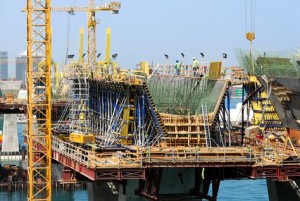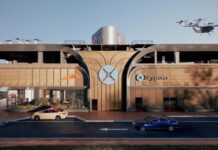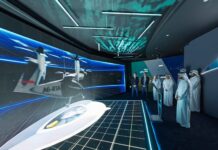By Benjamin Roberts www.arabianbusiness.com
The GCC has seen a flurry of activity in the bridges sector. News of projects nearing completion have quickly been replaced by a new set of tenders launched for the next set of projects, with the UAE and Saudi Arabia leading the ongoing work in both urban and rural environments as well as those spanning water.

Bridges have become a vital part of the ongoing infrastructure development of cities such as Abu Dhabi, based on the need to diversify traffic and provide neat solutions in increasingly dense building landscapes. Often the urban environment presents significant challenges to consultants and contractors – not least because the city must continue to function during the building process.
A prime example of this occurred in the construction of the AED830 million Mafraq Bridge in Abu Dhabi, which was opened this month. Coordinated by the Municipality of Abu Dhabi City, the 27-lane two-way structure aims to improve the efficiency of the existing bridge and enhance traffic flow. The Municipality had previously intended the phased opening of the completed parts, encompassing three bridges: a 75-metre, four-lane main bridge that has a shoulder in the direction of Dubai – Al Silaa; two bridges that will serve the traffic from Abu Dhabi towards Al Shahama; and a bridge from Al Ain towards Al Silaa.
Steve Drake, projects director for Al Jaber Transport and General Contracting, said work on the project represented a “massive footprint” on the surroundings that required a lot of careful planning.
“The problem is when the environment has existing utilities and integrating it with the surrounding area,” he says. “This is a challenge away from the technical aspects. Also, the project incorporated the demolition of the existing structure as well as dealing with the traffic.
“One thing that we did to make it easier was to change the original idea. To begin with, there was going to be a staggered opening where the use of the bridge would be phased in. We realised we couldn’t do this in parts, so we decided to take the traffic out of the critical part and create massive detours around the interchange. So in the early planning we came up with an alternative and it meant we could take the criticality away for the drivers.”
The company had to correspond with all related authorities concerning moving the underground pipelines that flow into the city, over which the work will be carried out.
“When you get a project you need to approach all the authorities and say ‘I’m about to start a job – tell us where you have a problem’. And they might say that they have a pipeline and ask us to explain how this will be relocated. We work with the information and come up with a solution and say ‘this is how we’re going to do it’.”
Utilities are often difficult to accommodate as they are often close together, or buried deep in the ground. Occasionally, says Drake, the contractor has to leave them where they are and simply protect them from damage. All this has an effect on the project timescale.
“The more complex the area above which you’re building, the more time it takes,” he says.
Bridge building has evolved greatly in the region, partly to meet the challenges of urbanisation and partly due to increasing confidence and ambition. The $3 billion Bahrain-Qatar Causeway, though stymied by political differences and a wider financial crisis, is perhaps the best example of this. A similar project to connect Saudi Arabia and Djibouti – set to be the world’s longest suspension bridge at 28 km – also hints at the drive to make the Middle East a smaller place by connecting foreign shores.
Khalil Doghri, general manager at Freyssinet Middle East, says the market has moved on from the “classical” approach of building the deck between the ‘piers’ – or columns – using scaffolding.
New methods include casting parts of the deck in situ (slabs are cast offsite and assembled onsite) as well as a technique called ‘incremental launching’ for concrete bridge construction. Both are newer ideas in the region than in more mature markets.
Incremental launching consists of manufacturing sections of the superstructure of a bridge in a prefabrication area behind one of the abutments. Each new unit is concreted directly against the preceding one, and after it has hardened the next unit is then added.
Technical insight
Freyssinet Middle East occupies an interesting area of consultancy for bridge projects, working with developers and consultants at the early stage of design at the pre-tender stage. Since bridges are one of the company’s specialisms – including the post-tensioning that allows bridges to be horizontal rather than an arch – the company adjusts elements of the design to make it the most cost effective as possible. The company then works with the general contractor.
The Dubai Metro was one such project where the company offered its services. For this project it was decided that the construction be segmented, so parts of the deck are precast elsewhere and assembled on site using a special gantry. “Sometimes if we can’t use the existing design,” he says, “the company proposes an alternative. We were able to achieve a segment for every two days. We own the specialist equipment, and it’s the first of its kind in the GCC.
“The role of post tensioning is to balance the dead weight and moving load,” he explains. Post tensioning allows an uplift force, balancing the surface load up and the total force acting on the bridge is reduced. It means there is less concrete and less rebar.”
Doka is another company with its own specific techniques that are expanding the options of bridge construction for contractors and consultants.
Though it still offers the classical model of scaffolding between piers, Bernhard Lindner, Gulf technical manager, says the company’s Cantilever Forming Traveller is gaining traction for bridges over water.
This is an all-in-one system (formwork plus traveller) enables speedy and safe construction of composite bridges comprising concrete carriageway slabs on steel superstructures. The product’s modular, flexible structure allows it to be used for forming straight, inclined and multi-cell box girder cross-sections. Essentially, these are structures that sit on top of piers and act as a base to allow the builders to build the bridge part by part until it meets in the middle with the progressed deck of the next pier.
Friedrich Kerschbaumer at PERI says it is vital that the construction of each side of the pier happens at an equal rate to remain balanced.
“This was the challenge for Saadiyat Island bridge,” he says, referring to the 10-lane structure, the second-largest in the region, that links the island to Abu Dhabi.
“Most of the projects we have been working on are in Abu Dhabi and Oman. What I hear from engineers is that there are a lot of tenders open. For some bridges there can be as many as 12-13 contractors [going for the contract].”
A number of bridge projects remain under construction across the region, including the Subiya Causeway, a 37km structure across the Bay of Kuwait connecting Shuwaikh Port with Subiya New Town Development, and the $50 million Hudayriat Bridge that will join the island to Abu Dhabi.
Doka’s Lindner sees significant potential for bridge and related projects in Doha. “Qatar has been growing enormously in the last few years. It has focused very much on road works recently – and there will be a lot more flyover systems needed in Qatar.”



















